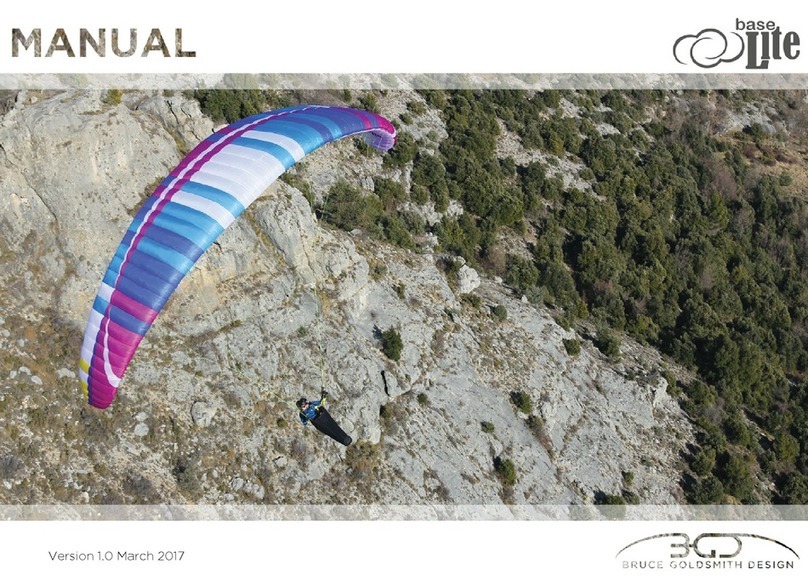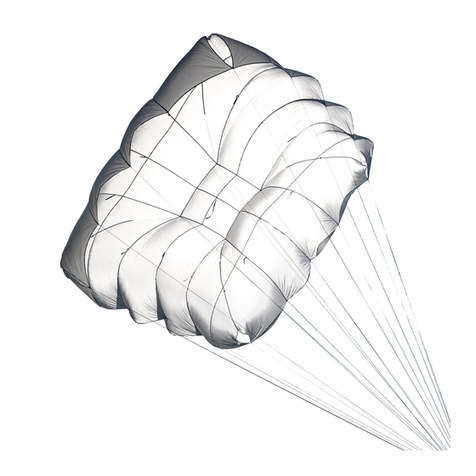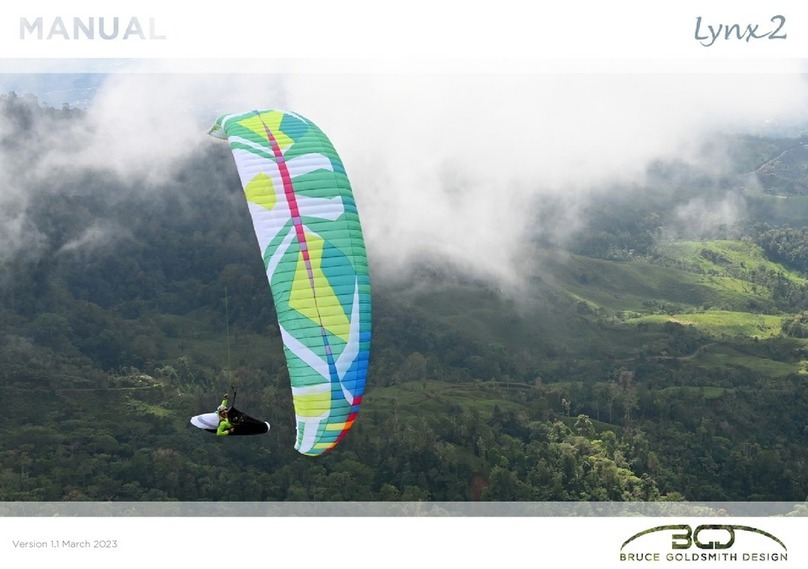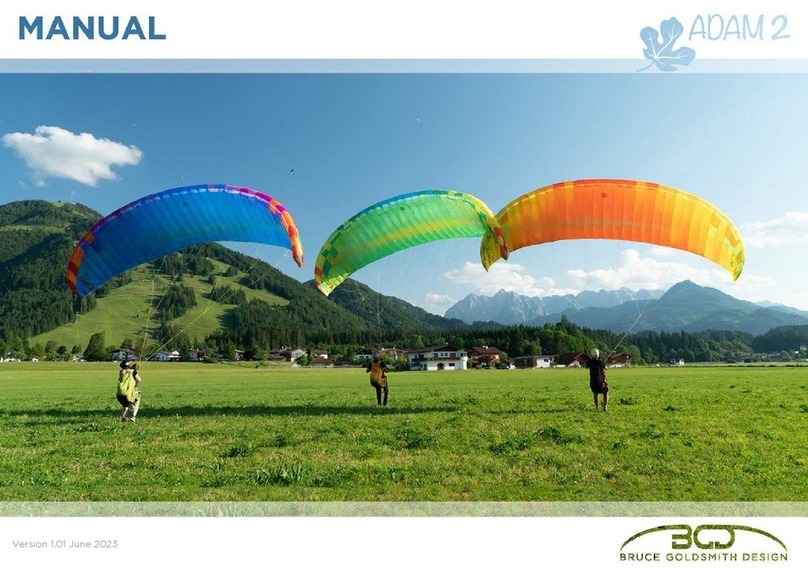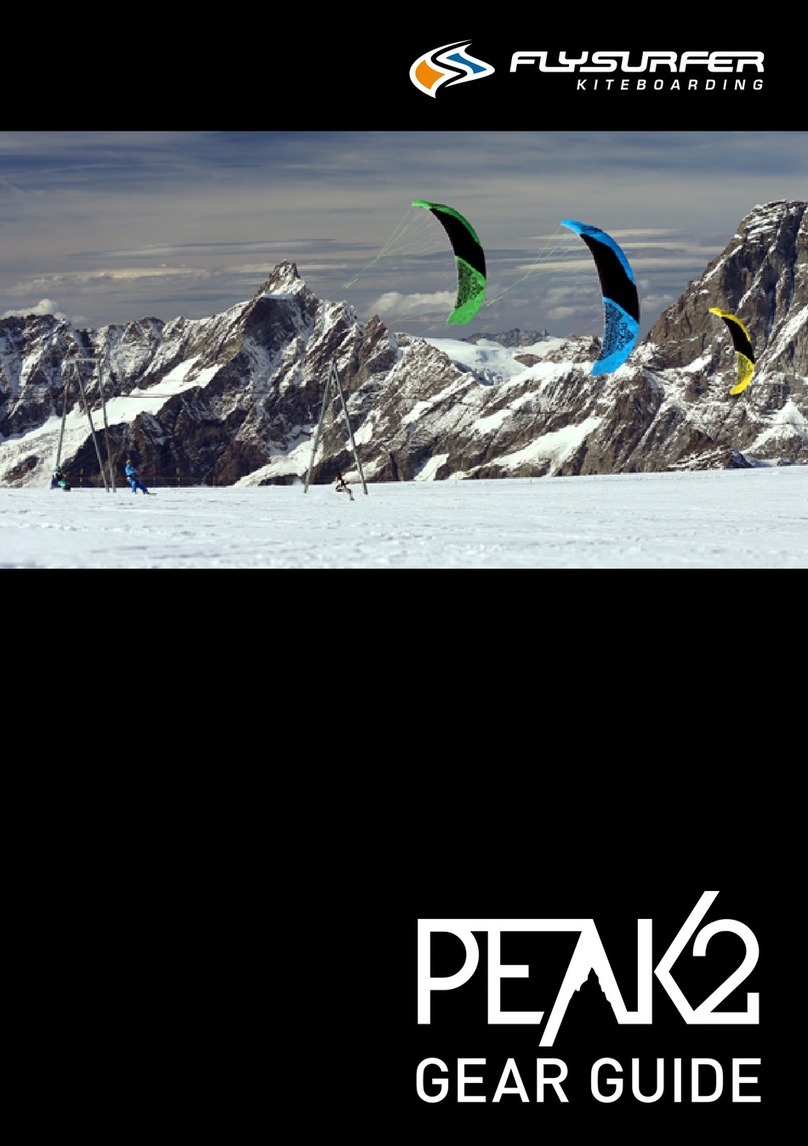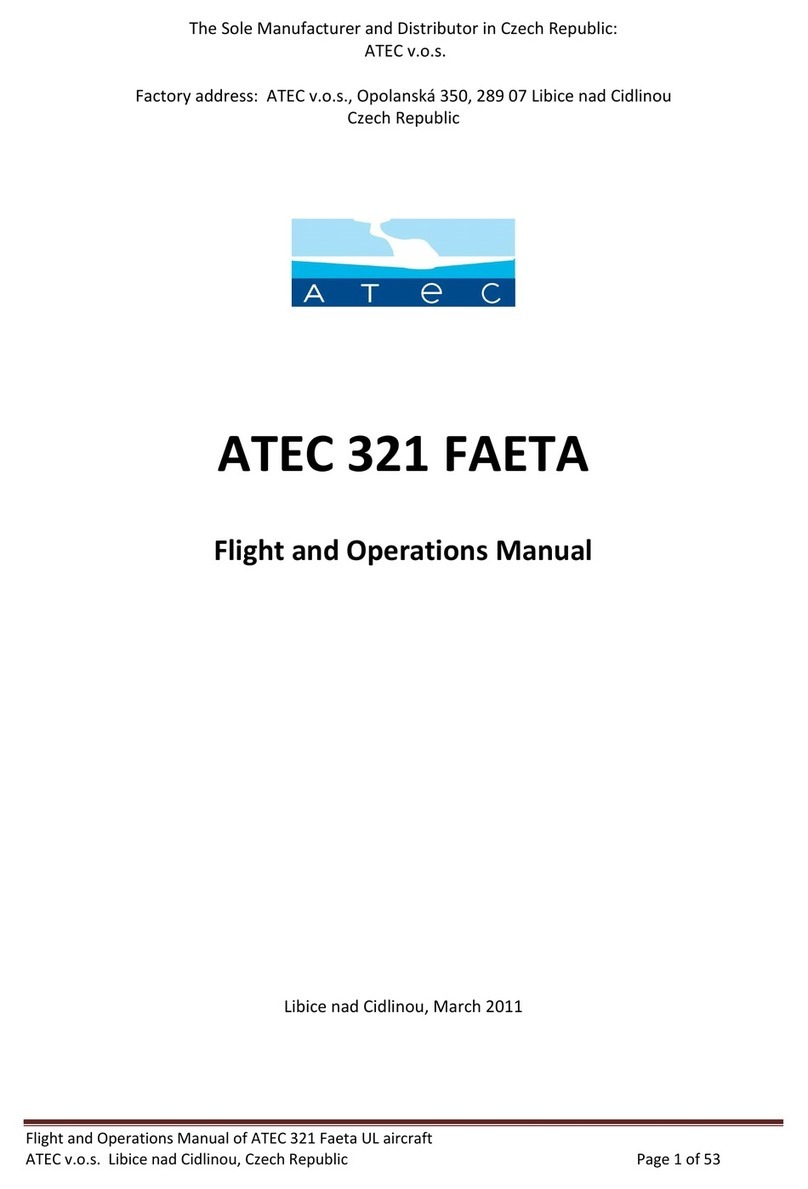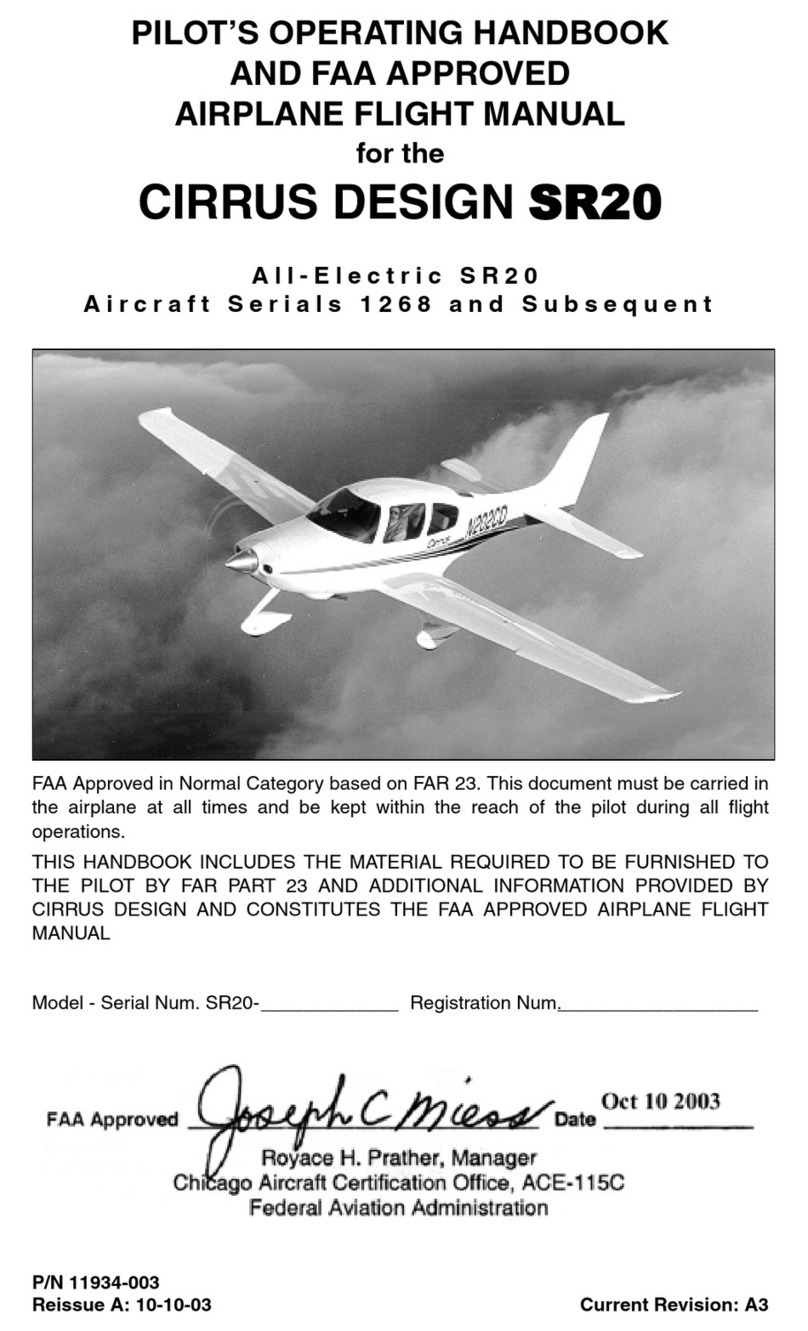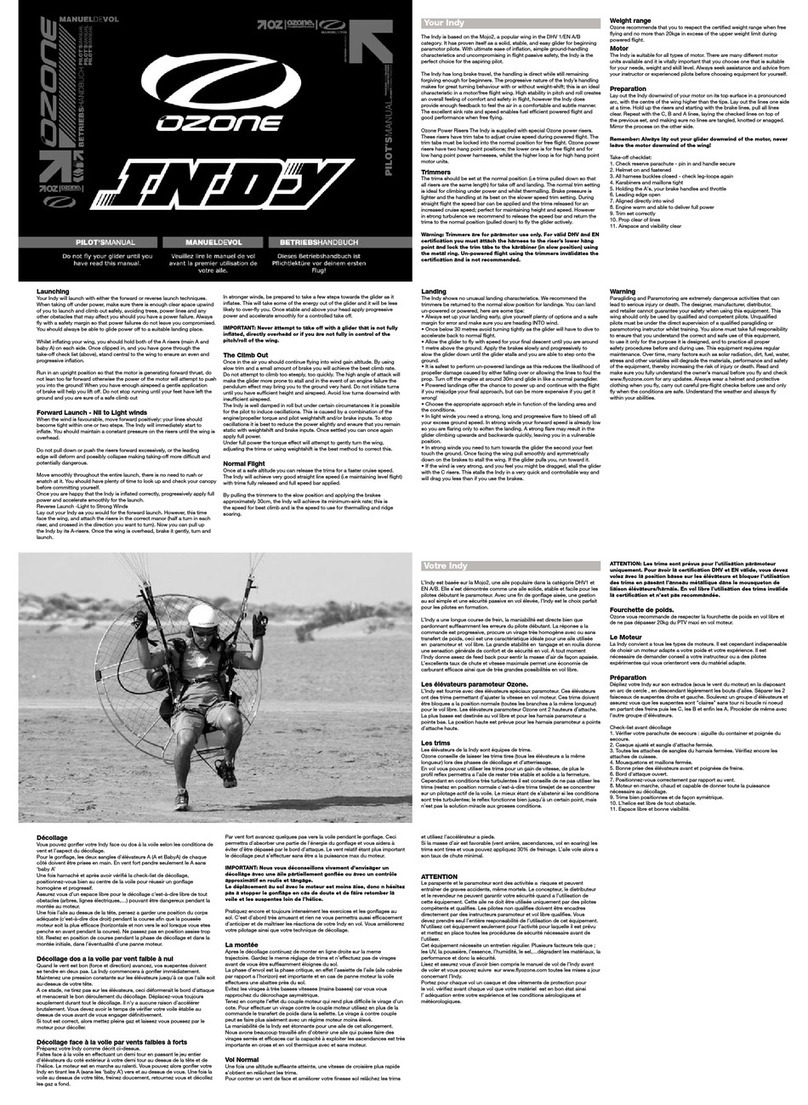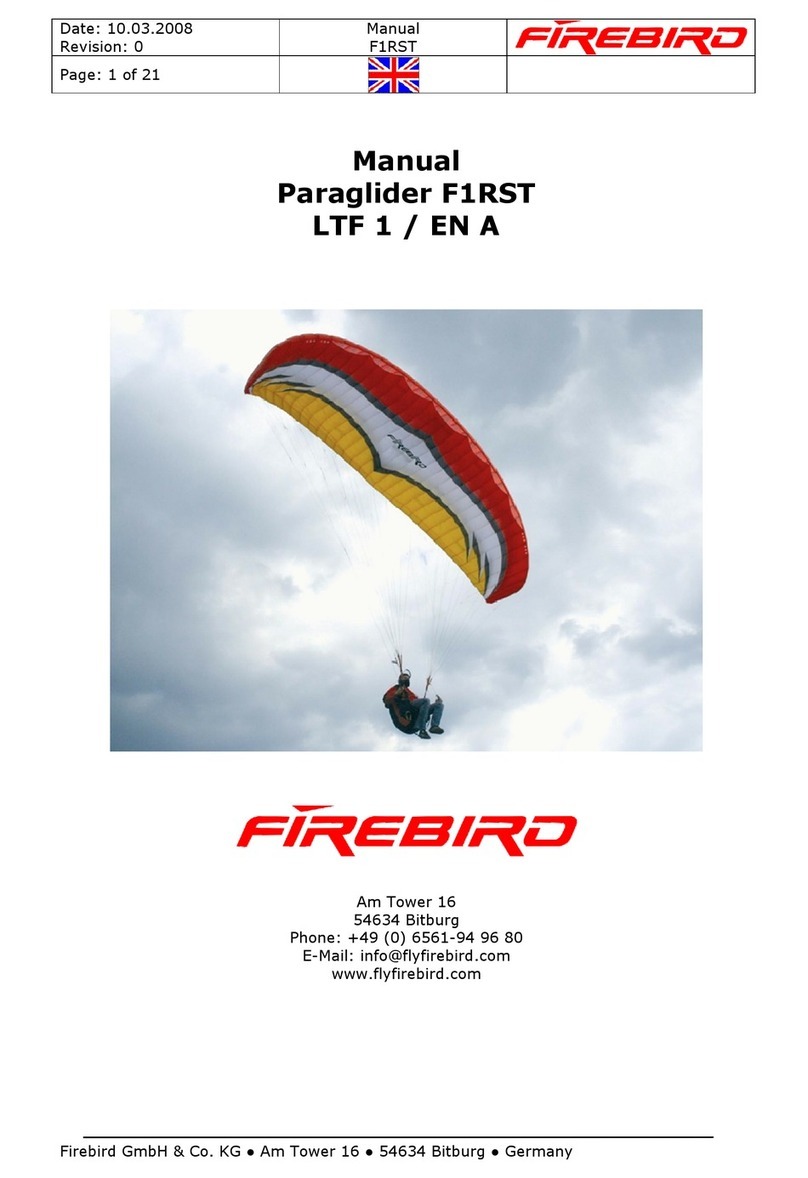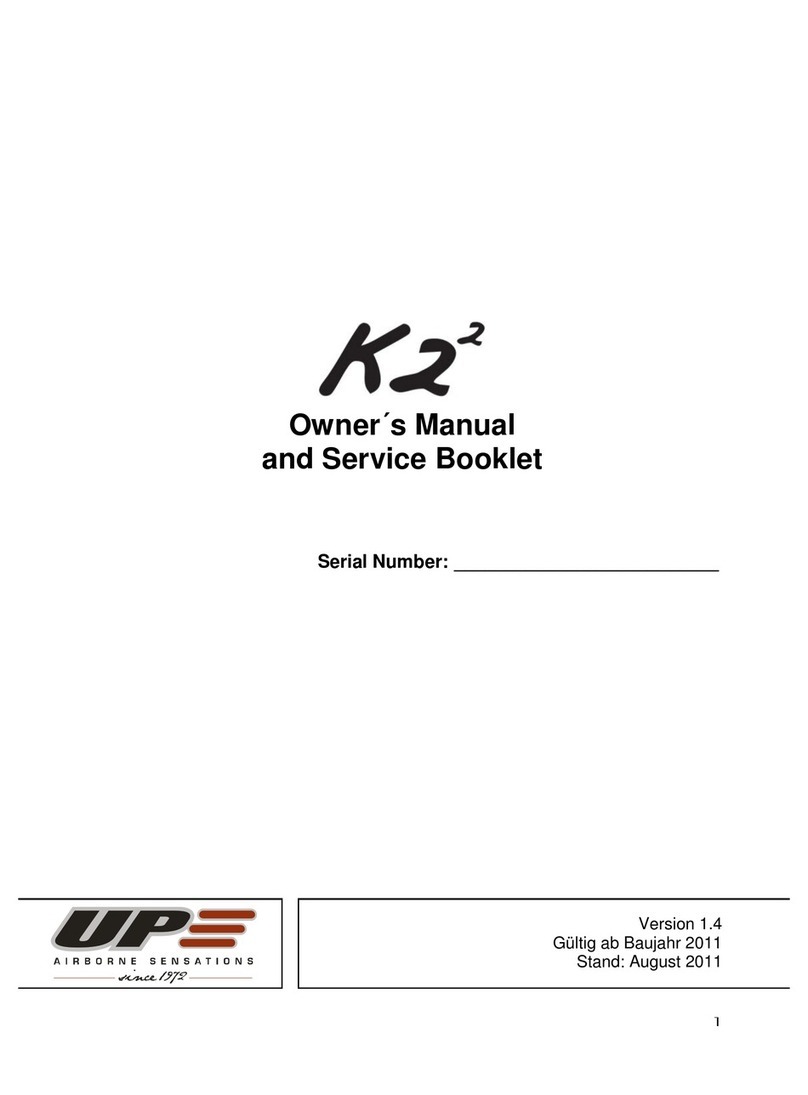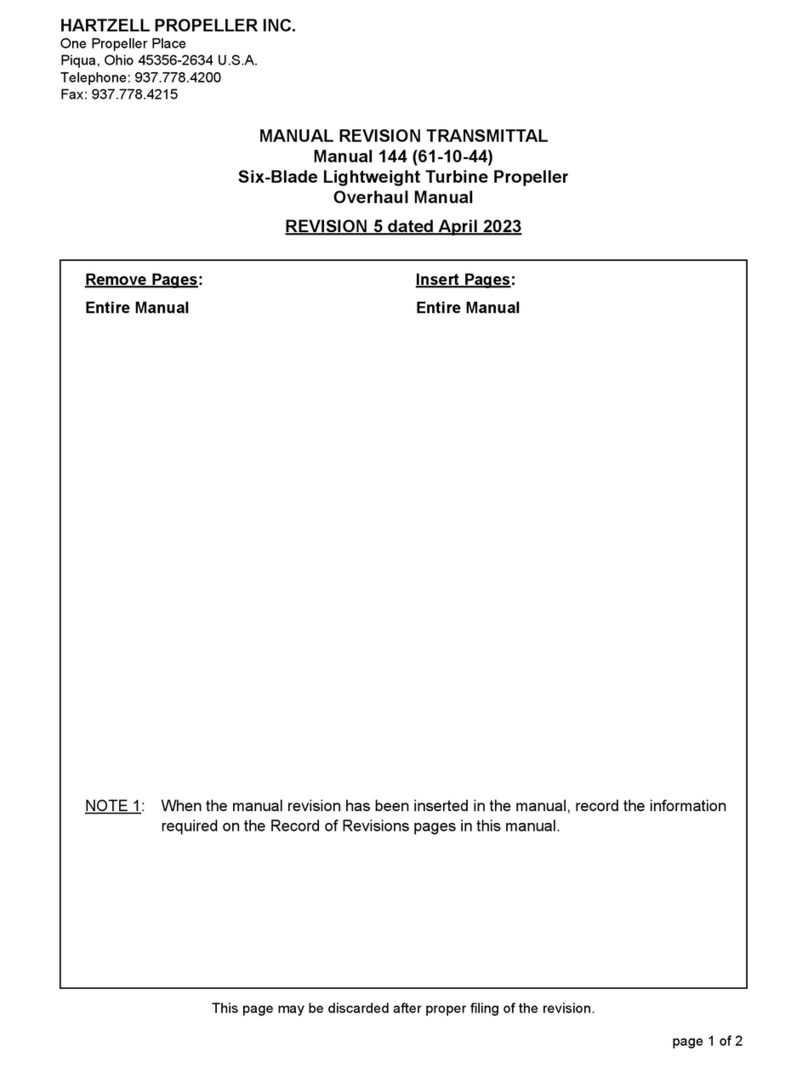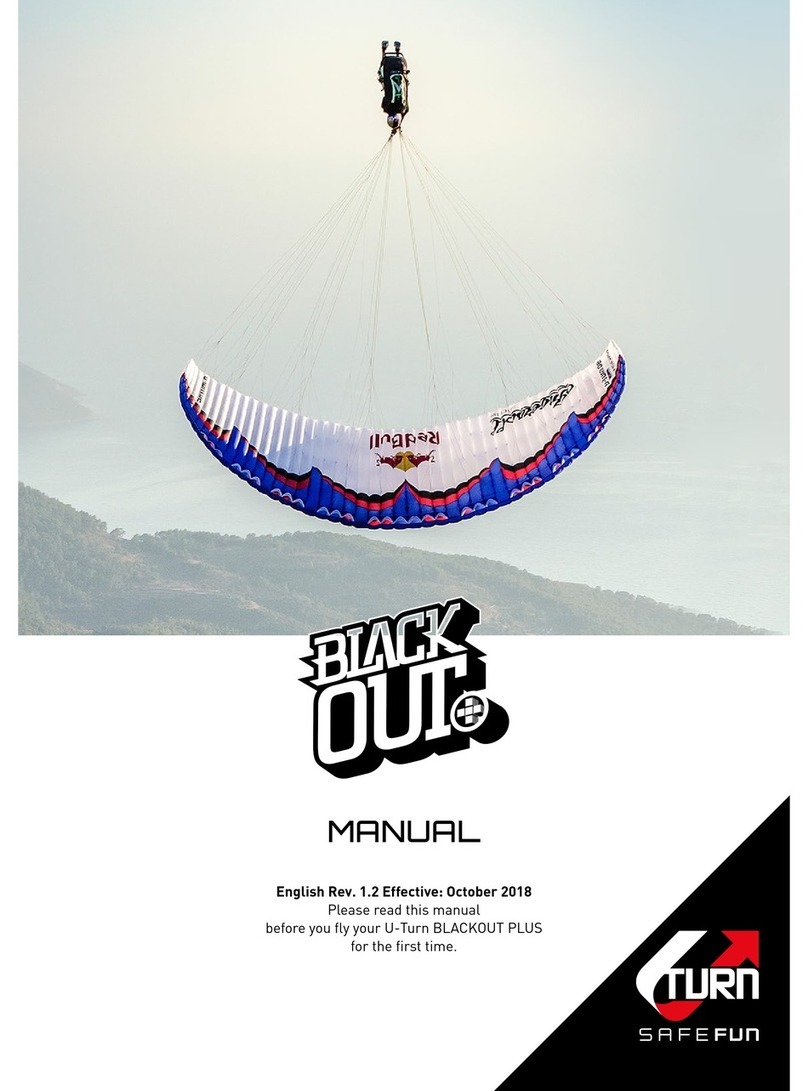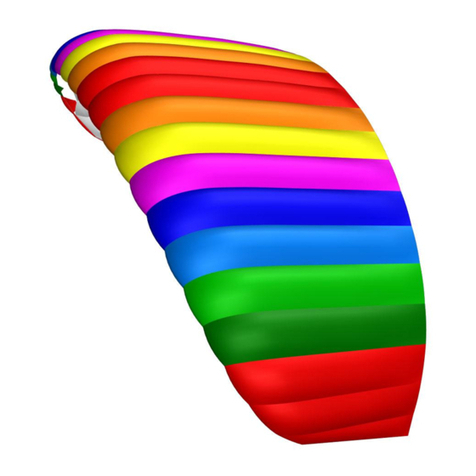BGD BLIZZARD User manual

1
BLIZZARD-manual-EN-1.1 March 2022Version 1.1 March 2022

2
BLIZZARD-manual-EN-1.1 March 2022
Contents
Contents
Welcome ............................................................. 3
Precautions......................................................... 4
Preparation ........................................................ 5
Riser diagram............................................... 6
Flight Characteristics..................................... 9
Recovery Techniques ................................... 15
Maintenance....................................................... 18
Technical Data ................................................. 24
Materials ......................................................... 24
Specications................................................ 25
Overview of glider parts.......................... 26
Line Plan.......................................................... 27
Line length checks..................................... 28
Service record................................................... 37
Owner records.................................................. 38
Closing words.................................................... 40

3
BLIZZARD-manual-EN-1.1 March 2022
BLIZZARD Owner’s Manual
DGAC certied paraglider for use with paramotor or trike
Welcome to Bruce Goldsmith Design
BGD is a world leader in the design and production of paragliders. For many years Bruce Goldsmith and his team
have been developing products with world-beating performance for pilots who want the best. We apply our
competitive knowledge to design top quality products that combine the highest performance with the safe handling
our customers value and respect. BGD pilots appreciate our quality and reliability. BGD´s world-class status is based
on the skills and expertise we have developed in combining aerodynamic design with cloth and materials technology.
All BGD products are developed and made with the same skill and attention to good design that are synonymous
with the ultimate performance and precision required by paragliders.
Congratulations on your purchase of the BGD BLIZZARD
The BLIZZARD is a progression wing for paramotoring. It is ideal for pilots who have completed their in-school ight
training, and who are ready to take their ying to the next level. It is easy to launch and y and has excellent stability,
and its performance and speed will be appreciated by pilots who are ready for longer, further cross-country ights.
The Blizzard ies equally well with a trike or with foot launch. In fact all the DGAC ight tests for the size 29 were
done at the maximum weight, with a trike.
Your wing has been designed to a high standard of safety and stability, but it will only retain these characteristics if
it is properly looked after. This manual has been prepared to give you information and advice about your paraglider.
Please read it carefully to ensure you get the best out of your new wing.
If you need replacement parts or further information, please contact your nearest BGD dealer.
Welcome

4
BLIZZARD-manual-EN-1.1 March 2022
Precautions
This glider is not intended to be used for aerobatic manoeuvres.
This paraglider must not:
1. Be own outside the certied weight range
2. Have its trim speed adjusted by changing the length of risers or lines
3. Be own in rain or snow*
4. Be towed with a tow-line tension in excess of 200 kg
*A wet canopy is much more likely to enter a parachural or full stall (see chapter 5). If you y into a rain shower, you
should immediately go and land somewhere safe, steering the canopy gently and avoiding manoeuvres such as Big
Ears which can make it more likely to stall.
Modications
Any modication, e.g. change of line lengths or changes to the speed system, can cause a loss of airworthiness and
certication. We recommend you contact your dealer or BGD directly before performing any kind of change.
Warranty
In order to benet from the BGD warranty, you are required to complete the warranty form on the website. It is
your dealer’s responsibility to test y a new paraglider before you receive it. Failure to test-y a new paraglider may
invalidate the warranty.
Precautions

5
BLIZZARD-manual-EN-1.1 March 2022
Preparation
Riser set-up
The risers on the Blizzard can be adapted to the height of the hangpoints of your paramotor frame/harness.
For a paramotor with low hangpoints the standard positions can be used for the brake attachment and the TST line
as shown in the riser image on the following page.
For a paramotor with high hangpoints you will need to do the following:
1. Take the brake lines and TST lines off the two handles they are knotted to.
2. Remove the brake leg which is attached to the upper webbing loop on the D
riser and move it to the lower position on the D riser.
3. Put the brake handle back on, and make sure that you lengthen the brake
lines by the distance between the loops (20cm).
4. Thread the TST line though the lower friction ring instead of the upper one.
5. Tie the TST handle back on also extended the TST line by the correct
amount.
6. The brake and TST lines should be long enough to allow the extension of the
lines. If they are not you will either need to get longer lines, or the line can be
extended at the top where it does not run though any rings or pullies.
Preparation

6
BLIZZARD-manual-EN-1.1 March 2022
Blizzard risers
Preparation
Trimmer
Brake-line pulley
Trimmer handle
Brummel hook
Roller cam
Accelerator system
Trimmer
Tip Steering handle (TST)
Brake-line swivel
Brake handle
Brake line
A riser
A’
B
D
Tip Steering line
Tip steering TST system
Friction ring
C

7
BLIZZARD-manual-EN-1.1 March 2022
On launch
• Select a suitable take-off area determined by wind and terrain, clear of any obstacles that may catch in the
lines or damage the canopy.
• Open out your paraglider so that the bottom surface is facing upwards, with the openings at the downwind
end of the take-off area and the power unit / harness at the trailing edge at the upwind side.
• Unfold the canopy to each side so that the leading edge openings form a semicircular shape, with the trailing
edge drawn together as the centre of the arc. The power unit / harness should be distanced from the canopy
so that the suspension lines are just tight.
• Prepare and check your power unit according to the manufacturer’s instructions.
• Connect the wing to the paramotor or trike, ensuring the risers are connected the right way round and that
the maillons or karabiners are correctly closed.
Pre-ight inspection
Your paraglider is designed to be as simple as possible to inspect and maintain but a thorough pre-ight procedure is
mandatory on all aircraft. The following pre-ight inspection procedure should be carried out before each ight.
1. Whilst opening out the paraglider check the canopy for any tears.
2. Check that the lines are not twisted or knotted. Divide the suspension lines into groups, each group coming
from one riser. By starting from the harness and running towards the canopy remove any tangles or twists in
the lines. Partially inating the canopy in the wind will help to sort out the lines.
3. It is particularly important that the brakes are clear and free to move. Check the knot which attaches the
Preparation

8
BLIZZARD-manual-EN-1.1 March 2022
brake handles to the brake lines. Avoid having too many knots, as they could become stuck in the brake
pulleys. Both brakes should be the same length and this can be checked by asking an assistant to hold the
upper end of the brake lines together while you hold the brake handles. The brake lines should be just slack
with the wing inated when the brakes are not applied. After checking the brake lines lay them on the ground.
4. Always check the riser maillons and the attachment points to the paramotor frame or trike. The use of a
safety strap is strongly recommended. Before getting into the harness you should be wearing a suitable
helmet. Put on the harness ensuring all the buckles are secure and properly adjusted for comfort.
5. Ensure the trimmers are set to the rst marker, which is the recommended position for take-off.
Your paraglider is now ready for ight.
Take care to protect yourself and other people from the propeller. Always start your motor up at a safe distance
away from other people. The blades can pick up and re out debris which could injure people several metres away.
Remember there are inherent risks with petrol, oil and volatile or ammable materials.
Preparation

9
BLIZZARD-manual-EN-1.1 March 2022
Flight Characteristics
This manual is not intended as an instruction book on how to y your paraglider. You should be a qualied pilot or
under suitable supervision, but the following comments will help you to get the best from your wing.
Weight range
Each size is certied for a certain weight range. The weight refers to the ‘overall take-off weight’. This means the
weight of the pilot, the glider, the harness, the paramotor or trike and all other equipment carried with you in ight.
We recommend your paraglider is own in the middle of the weight range.
If you y in the lower half of the weight range the turning agility will be lower and the glider will be more damped,
but it will have a slightly increased tendency to collapse in strong turbulence. If you mainly y in weak conditions you
might choose to y towards the lower end of the weight range.
If you y in the upper half of the weight range you will have greater agility and speed, and greater stability in
turbulence, but your wing will be less damped in turns and after collapses. If you prefer a dynamic ight characteristic
you should choose to y higher in the weight range.
You should never y a paramotor in strong turbulence or violent winds.
Take-off
Your paraglider is easy to inate in light or stronger winds and will quickly rise overhead to the ying position. The
best ination technique is to hold one A-riser in each hand.
It is best to launch with the trimmers set to the rst position (see diagram on p6).
Flight Characteristics

10
BLIZZARD-manual-EN-1.1 March 2022
Never try to launch if the wing is not perfectly inated above your head and you do not have full control of pitch and roll.
Initial Climb
Once in the air you should continue to y into wind while gaining altitude. Leave the trimmers in the take-off position
to get the best climb rate.
Do not attempt to increase your climb rate by braking, as using the brakes combined with the engine’s thrust can
increase the angle of attack to the point where the wing can stall. In addition, this high angle of attack can result in a
big dive if the motor suddenly dies, which could be dangerous if you are near the ground.
Do not initiate a turn until you have enough height and speed to do so.
Trimmers and Speed bar
The trimmers allow easy fast cruising. After take-off, once you have gained a safe altitude, you can open up the
trimmers progressively to increase your speed. The speed bar can be used at the same time for a signicant increase
in speed.
Important note on using the trimmers
Trimmers should be pulled backwards or down when applied.The trimmer should not be pulled to the side or
in towards the pilot, as this will cause the webbing to rub on the trimmer buckle causing premature wear on the
trimmer. Take care to avoid this issue especially when ying with a trike.
Both trimmers and speed bar increase the speed of the paraglider and activate the reex system. Even with the
trimmers open and the speed bar fully applied, the brakes can be used without causing a front collapse. However,
whenever the trimmers are open to more than about half, or half-speedbar is applied, it is better to use tip steering
instead of brakes as it retains the reex prole and allows you to turn without losing speed.
Flight Characteristics

11
BLIZZARD-manual-EN-1.1 March 2022
In turbulent air it can be useful to have the trimmers open to better absorb turbulence, but it is safer not to apply full
speedbar at the same time, to avoid a frontal collapse.
To reduce fuel consumption or to y in thermals, the trimmers should be closed, pulled down to their maximum.
Maximum speed is with the trimmers released and the speedbar pushed out fully so that the pulleys touch. Do not
push the speedbar beyond this limit in an attempt to attain a higher speed. To y at full-bar the speed stirrup should
be applied gradually until the two pulleys on each A-riser touch. Do not go beyond this point by using excessive force
to attempt to make the glider go faster as this may result in the glider collapsing.
The Blizzard has roller-cam trimmers, which are smooth to operate and reduce wear on the webbing. Nonetheless, it
is important to regularly check the wear on the trimmers and that the system is functioning cleanly with no sticking
points. If they are showing signs of wear, the trimmers should be replaced. This can be done by the pilot.
Turning
Your rst turns should be gradual and progressive. The initial action to change direction should be the movement of
your weight in the harness towards the side of the intended turn. Then gently relax the pressure on the outer brake,
and gently apply pressure to the inner brake until you attain the desired bank angle.
To adjust your speed and turning-circle size, coordinate your weightshift with pressure on the outer brake. How
your glider reacts to weightshift will depend on the type of paramotor setup you use, for instance with a trike no
weightshift at all is possible.
Remember that to violently apply high force on the brakes is dangerous and should be avoided. Never initiate a turn
if you are ying slowly, as you risk the glider entering a spin.
Flight Characteristics

12
BLIZZARD-manual-EN-1.1 March 2022
Tip Steering System, TST
The Tip steering system can be used to turn without slowing the glider. This is the usual way to turn when you have
the trimmers released. It can also be used in conjunction with the brakes to adjust the characteristics of the turn.
Unintended Oscillations
In certain circumstances, a pilot can induce unintended oscillations. This can be due to a combination of the engine/
propeller and pilot’s weightshift and / or action on the brakes. To stop unintended oscillations you should reduce the
power, ensure that you are seated centrally and not accidentally applying weightshift, and that you are not acting on
the brakes. Once the oscillations have stabilised you can gently reapply power.
Landing
Set the trimmers to the closed position and set up your approach downwind of the landing eld. When your height
above the eld is around 40m and you are in a good position to land in your intended landing spot, switch the engine
off* and make your nal approach, keeping your hands up to keep plenty of energy in the wing until you are about
a metre above the ground. Flare, braking slowly and gradually to slow down the wing until you are close to the stall
point and able to land on your feet.
*If you land with the engine running there is a considerable risk of rotational propeller damage (eg lines passing
through the propeller, or even injury).
Active Piloting
Active piloting means ying in empathy with your paraglider. This means guiding the glider through the air and
controlling the movements of the wing, especially in thermals and turbulence. If the air is smooth the wing does not
need much input from the pilot, but in turbulent air a continual action of the pilot on the brakes and in the harness is
Flight Characteristics

13
BLIZZARD-manual-EN-1.1 March 2022
necessary. These reactions are instinctive in experienced pilots. It is essential to maintain contact with the paraglider
by a light pressure on the brakes. This allows you to feel the decreases in the wing’s internal pressure which often
precede collapses. Remember, you should not y a paramotor in windy or turbulent conditions.
Rapid Descent Techniques
Big Ears
The ‘baby A-riser’ allows the wing tips of the paraglider to be folded in simply and easily to increase its sink rate.
Applying big ears allows you to descend quickly without substantially reducing the forward speed of the canopy
(in contrast with the B-line stall, which substantially reduces the canopy’s forward speed). To engage big ears, lean
forward in the harness and grasp the baby A-risers, one in each hand, at the maillons, keeping hold of both brake
handles if possible. Pull the risers out and down at least 30cm to collapse the tips of the glider. It is very important
that the other A-lines are not affected when you do this, as this could cause the leading edge to collapse. Steering
with big ears in is possible by weightshifting. If the big ears do not come out quickly on their own, a gentle pump on
the brakes will speed things up.
Before using big ears in earnest, it is essential to practise beforehand with plenty of ground clearance in case a
leading edge collapse occurs. Always keep hold of both brakes in order to retain control.
B-Line Stall
This fast descent method is a useful emergency procedure. Keeping hold of both brake handles, grasp the top of
the B-risers, one in each hand, and pull them down by around 10-15cm. This will stall the canopy and forward speed
will drop to zero. Make sure you have plenty of ground clearance because the descent rate can be over 10 m/sec.
To increase the descent rate, pull harder on the B-risers. When you release the B-risers the canopy will automatically
start ying again, normally within two seconds. Sometimes the canopy will turn gently when it exits from the B-line
stall. It is usually better to release the B-risers fairly quickly rather than slowly, as doing so slowly may result in the
canopy entering deep stall. Always release the risers symmetrically, as an asymmetric release from a B-line stall may
cause the glider to enter a spin.
Flight Characteristics

14
BLIZZARD-manual-EN-1.1 March 2022
This manoeuvre is useful if you need to lose a lot of height quickly, perhaps when escaping from a thunderstorm. It
should not be performed with less than 100m of ground clearance (see also also Recovery Techniques).
Spiral Dive
A normal turn can be converted into a strong spiral dive by continuing to apply one brake. The bank angle and speed
of the turn will increase as the downward spiral is continued. Be careful to enter the spiral gradually as too quick a
brake application can cause a spin or an over-the-nose spiral.
BGD gliders are designed and tested to recover automatically from normal spirals with a descent rate inferior to 16
m/s, without pilot input. If the pilot increases the descent rate of the spiral to over 16 m/s or initiates what is known as
an over-the-nose spiral, the glider may require pilot input to recover. In this case all the pilot needs to do is to apply
some outside brake and steer the glider out of the turn.
The over-the-nose spiral is a spiral dive where the glider points almost directly at the ground. It will enter this if you
make a sudden brake application during the spiral entry so that the glider yaws around. The nose of the glider points
at the ground, and it picks up speed very quickly. This technique is very similar to SAT entry technique, and like
the SAT it is an aerobatic manoeuvre which is outside the normal safe ight envelope. Please do not practise these
manoeuvres without proper supervision, as they can be dangerous.
Care should be taken when exiting from any spiral dive. To pull out of a steep spiral dive, release the applied brake
gradually or apply opposite brake gradually. A sharp release of the brake can cause the glider to surge and dive as
the wing converts speed to lift. Always be ready to damp out any potential dive with the brakes. Also be ready to
encounter turbulence when you exit from a spiral because you may y though your own wake turbulence, which can
cause a collapse.
CAUTION: Spiral dives can cause loss of orientation (black out) and some time is needed to exit this manoeuvre. This
manoeuvre must be exited in time and with sufcient height!
Flight Characteristics

15
BLIZZARD-manual-EN-1.1 March 2022
Recovery Techniques
Recovery Techniques
All of the following manoeuvres can be dangerous, and should only be practised in a secure environment, such as an
SIV course.
Stalls
Stalls are caused by ying too slowly. Airspeed is lost as brake pressure increases and as the canopy approaches the stall
point it will start to descend vertically and nally begin to collapse. Should this occur it is important that the pilot releases the
brakes at the correct moment. The brakes should never be released when the wing has fallen behind the pilot; the brakes
should be released fairly slowly, to prevent the forward dive of the canopy from being too strong. A pre-release of the brake
and the reconstruction of the full span is recommended to avoid the tips getting cravatted during the recovery.
Deep Stall (or Parachutal Stall)
Your paraglider has been designed so that it will not easily remain in a deep stall. However, if it is incorrectly rigged
or its ying characteristics have been adversely affected by some other cause, it is possible that it could enter this
situation. In the interests of safety all pilots should be aware of this problem, and know how to recover from it. The
most common way of ending up in deep stall is from ying too slowly, from a B-line stall or even from big ears.
When in deep stall the pilot will notice the following:
1. Very low airspeed.
2. Almost-vertical descent (like a round canopy), typically around 5m/s.
3. The paraglider appears quite well inated but does not have full internal pressure. It looks and feels a bit limp.
Recovery from deep stall is quite simple: The normal method is to simply initiate a mild turn. As the canopy starts to
turn it will automatically revert to normal ight, but it is important not to turn too fast as this could induce a spin.

16
BLIZZARD-manual-EN-1.1 March 2022
Recovery Techniques
The second method is to pull gently on the A-risers. This helps the airow to re-attach to the leading edge, but be
careful not to pull down too hard as this will induce a front collapse.
If the previous methods do not work then a full stall will solve the problem. To do this apply both brakes again fairly
quickly, as if to do a strong stall, then immediately release both brakes and damp out the forward surge in the normal
way. The canopy will swing behind you then automatically reinate and surge forward in front of you before returning
to normal ight. It is the surge forward that exits the canopy from deep stall.
Spins
A spin can occur if the pilot tries to turn too fast. In a spin the pilot, lines and canopy basically stay vertical and rotate
around a vertical axis. Your glider will resist spinning, but if a spin is inadvertently induced you should release the
brake pressure and be ready to damp out any dive as the glider exits the spin. Failure to damp the dive on exiting the
spin may result in an asymmetric deation.
Symmetric Front Collapse
It is possible that turbulence can cause the front of the wing to symmetrically collapse, although active piloting can
largely prevent this from occurring accidentally. A pilot can reproduce the effect by taking hold of both the A-risers
and pulling down sharply on them. The glider will automatically recover on its own from this situation in around three
seconds. During this recovery period it is advisable not to apply the brakes as this could stall the wing.
Asymmetric Front Collapse
Your paraglider is very resistant to deations, but if the canopy does collapse on one side due to turbulence, you should rst
of all control the direction of ight by countering on the opposite brake. Most normal collapses will immediately reinate on
their own and you will hardly have time to react before the wing reinates automatically. The act of controlling the direction
will tend to reinate the wing. However, with more persistent collapses it may be necessary to pump the brake on the

17
BLIZZARD-manual-EN-1.1 March 2022
collapsed wing using a long, strong, smooth and rm action. Normally one or two pumps of around 80cm will be sufcient.
Each pump should be applied in about one second and smoothly released. In severe cases it can be more effective to pump
both brakes together to get the canopy to reinate. Be careful not to stall the wing completely if this technique is used.
Releasing a trapped tip (cravat)
Following a severe deation it is possible for a wingtip to become trapped in the glider’s lines (cravat). If this occurs
then rst of all use the standard method of recovery from a tip deation as described in Asymmetric Front Collapse
above. If the canopy still does not recover then pull the rear risers to help the canopy to reinate. Pulling the stabilo
line is also a good way to remove cravats, but remember to control your ight direction as your number-one priority.
If you are very low then it is much more important to steer the canopy into a safe landing place or even throw your
reserve.
NOTE: Test pilots have tested your paraglider well beyond the normal ight envelope, but these tests are carried
out in a very precise manner by trained test pilots with a back-up parachute, and over water. Stalls and spins on any
paragliders are dangerous manoeuvres and are not recommended.
Loss of brakes
In the unlikely event of a brake line snapping in ight or a handle becoming detached, the glider can be own by
gently pulling the rear risers for directional control.
Recovery Techniques

18
BLIZZARD-manual-EN-1.1 March 2022
Maintenance
Storage
Always store the canopy in a dry, warm place. Ideally this should be in the temperature range of 5°C to 25°C. Never
let your canopy freeze, particularly if it is damp.
If you have to pack your canopy away wet, do not leave it for more than a few hours in that condition. As soon as
possible dry it out, but do not use direct heat sources as it is ammable!
Your paraglider is made from high quality nylon which is treated against weakening from ultraviolet radiation.
However, UV exposure will still weaken the fabric and prolonged exposure to harsh sunlight can severely compromise
the safety of your canopy. Therefore once you have nished ying, put your wing away. Do not leave it laying in
strong sunshine unnecessarily.
Do not treat your canopy with chemical cleaners or solvents. If you must wash the fabric, use warm water and a little
soap. If your canopy gets wet in sea water, wash it with warm water and carefully dry it.
Small Repairs
Small tears in the top or bottom surface (not normally the ribs) of a canopy can be repaired with a patch of self-
adhesive ripstop nylon. Tears of up to 100mm can be repaired in this way providing they are not in a high-stress area.
Maintenance

19
BLIZZARD-manual-EN-1.1 March 2022
Lines
Releasing line loops
All BGD gliders are rigged from new with loops on the
maillons of the C lines (and D lines if any) plus the stabi
line. The loops are there so that they can be released to
compensate for any shrinkage of the back lines as the
glider gets older.
We recommend releasing the loops after 100 hours or
one year, whichever comes rst, or earlier if the pilot feels
the glider does not come up as easily on launch.
Line lengths are checked as part of a glider service. When
the rst service is carried out, normally at two years, the
loops should already have been released, and this should
be veried and ne-tuned by the check centre.
Replacing lines
If you need to replace lines on your glider, we recommended that a professional should mount the new lines. The
airworthiness of your glider, and your safety, depends on it being done correctly.
You can identify the line(s) you need to replace from the line layout diagram for your wing. Download the latest
version here: https://tinyurl.com/BGDlines
Replacement lines can be ordered from the Accessories section of the BGD website. Check that the lines you have
received correspond with the line layout diagram, and that this matches the line layout of your wing.
Left: loops on maillons; Right: loops released
Maintenance

20
BLIZZARD-manual-EN-1.1 March 2022
The quickest way to remove the old lines is to cut them off. (Don’t cut the old lines off if you have not received the
new ones or you may end up not being able to y!). Sometimes only a part line set is needed (eg excluding top lines
or brakes) so take care not to cut any lines that need to be retained.
It is important that lines are mounted the correct way up (see diagram on the following page). Microlines have
internal reinforcing in one end, marked by yellow thread. This must be put on the line-junction end. The non-
reinforced end is marked with white thread and should be attached to the glider tab or the maillon.
Sheathed lines have no additional reinforcing and can be mounted either way up.
Tab Alignment
Lines should be symmetrically placed on the tab, except where the tab is inclined. The A tabs are inclined backwards
on all BGD gliders, to align with the direction of pull of the line. So when assembling the lines, the A tabs should be
angled back, and the B, C and D tabs should be perpendicular to the undersurface.
Line Loops
New lines should be mounted on the maillons without loops on the A and B risers. The Stabi line and the C risers
should have a single loop on the maillon.
Maillon Inserts
The maillons have black plastic inserts to stop them coming undone accidently and the lines falling off. Always ensure
these are correctly installed after rigging the glider. If they are lost then use a locktight to secure the maillon closed.
New inserts can be ordered at www.ybgd.com.
Check before ying
After rigging, always do a full dimensional line check of the wing, and also inate the wing to check everything is
correct before ying.
Maintenance
Table of contents
Other BGD Aircraft manuals
